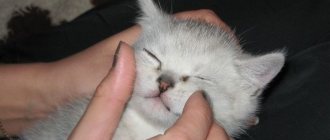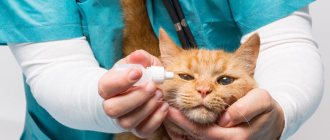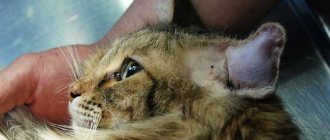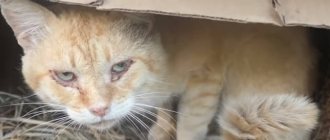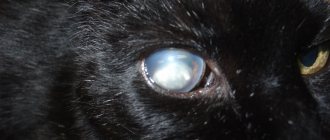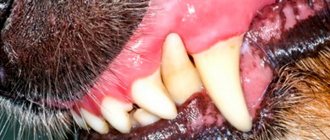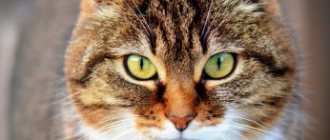An unpleasant discovery that sometimes befalls cat owners is the presence of an area on the cornea that outwardly differs from a healthy eye in reduced transparency and color. It looks whitish and opaque. This cloudiness is called a cataract. It can appear in both a kitten and an adult animal. Some owners believe that the cataract invariably leads to blindness and there are no methods for treating it. This is not true: in many cases, correct and timely assistance can save a pet’s vision, so diagnosis and treatment should begin immediately after the discovery of a cataract.
What it is
Leukoma in cats is a pathological condition characterized by the appearance of a scar on the cornea, the formation of which can be caused by various ophthalmological diseases.
What does leukoma indicate?
As the disease progresses, changes occur in the organ of vision. The animal begins to behave differently: hide from the light, look for secluded places.
The cat's tear production increases.
Consequences of ignoring the problem
If dangerous changes are not detected in a timely manner, the cataract will degenerate into adipose tissue. This condition can lead to complete atrophy of the eye. In addition, the disease causes a lot of inconvenience to the cat.
The resulting film provokes a decrease in visual acuity, especially when localized on the pupil itself.
What should the owner do?
Check your cat's eyes at least twice a day. If you see signs of a worsening process, that is, increasing redness, loss of vision, pain reactions or an increase in the volume of exudate, call the veterinarian immediately. If even before the start of treatment the cat’s vision has become noticeably worse, allocate it a minimally furnished room. This is done so that she does not accidentally get injured by running into a table leg, for example.
Don't let your cat rub his eyes. To do this, ask your treating veterinarian for a surgical collar for the animal, since there is simply no other reliable way. Never self-prescribe medications, especially those intended for humans. Believe me, taking some Visine for glaucoma is pointless. And certainly do not practice “treatment” with powdered sugar, which is quite dangerous for the cornea, without at least first consulting with a specialist.
On the contrary, give your pet all the medications prescribed by the veterinarian exactly on time and in full doses, and regularly take your cat to him for appointments.
A cat's eyesore is a serious condition that can lead to partial or complete loss of vision. Even the owner of a purring cat can visually identify the thorn - the affected eye seems to have become cloudy and changed color. If you suspect something is wrong, you need to take your pet to the vet as soon as possible.
Types of pathology
An eyesore is classified according to several criteria.
By location type
Highlight:
- peripheral;
- total;
- central.
In the first case, the pupil is not affected; the spot is mainly localized on the side of the eyeball, has a white tint and black inclusions.
With the total type, the cataract completely covers the entire eye.
In the central form, the center of the visual organ is affected, and complete occlusion of the pupil is often noted.
According to the pathological process
Leukoma can be congenital or acquired . The first type of disease is rarely diagnosed and occurs against the background of negative changes in the cat’s body that occurred during the period of intrauterine development.
The second form is more common and can be caused by many factors.
Causes
A cataract can form in cats for various reasons. Most often, veterinarians are faced with a disease that develops due to various viruses and infections that have entered the body. After a viral infection or any other disease is treated, an early stage thorn can go away quite quickly without additional therapy. In addition, leukoma develops in the following cases:
- with mechanical damage to the cornea;
- in case of allergic reactions caused by poor-quality food or medications used;
- during inflammatory processes in the body;
- for cataracts and bacterial keratitis in animals;
- Any diseases of the eye organs provoke the development of cataracts.
Causes of cataracts
Various factors can contribute to the formation of a cloudy film and stain. The problem in kittens is identified in rare cases when the cat suffered from infectious diseases at the time of birth.
Among the main reasons that provoke a thorn are the following:
- dysfunction of the endocrine system;
- eye injury;
- failure to comply with hygiene rules;
- infections;
- unbalanced diet.
Caring for a cat with an eyesore
In addition to the treatment prescribed by your veterinarian, adhere to the following rules for caring for a sick animal:
Assess your eye condition twice daily.
If the spot gets larger, visit your doctor again.
For a pet with poor vision, it is better to arrange the indoor environment with a minimum number of pieces of furniture. This tactic helps to avoid injury.
A furry pet should not rub its irritated eye; for this, the doctor puts on a special collar.
Put aside eye drops created for people like Visine; you cannot try them on a cat.
Strictly adhere to the doctor's instructions; if positive results from the treatment regimen are not visible, change the veterinarian.
Clear, clean eyes of a cat characterize its healthy visual apparatus. If the eyes look cloudy or covered with a whitish veil, then this is an eyesore in the cat, the treatment of which must be started immediately. Why leukoma develops and how to treat it is described in this article.
Diseases in which ocular leukoma develops
Veterinarians identify some pathologies that can lead to clouding and the appearance of a white spot on the visual organ.
Trachoma
This is a disease of infectious nature. In most cases, eye damage is accompanied by the formation of a cataract.
Inflammation on the cornea
One of the most common provoking factors of the disease.
If veterinary care is not provided in a timely manner, the risk of pupillary clouding increases several times. The superficial form is characterized by a weak degree of severity, and the thorn is almost invisible.
Preventive measures
It is easier to prevent any illness than to treat it later. Therefore, if the visual organ is injured, the mustache should be immediately taken to the hospital for examination.
At the same time, do not forget about scheduled vaccinations and regular preventive examinations of your pet.
Plan your cat's menu - it should include all the necessary macro and microelements, as well as vitamins. Protect your purr as much as possible from all kinds of chemicals and toxic substances.
If you suspect a disease of the visual organ, you should not use medications without first consulting a specialist. Also, do not use drugs intended for humans.
Symptoms of pathology
It is difficult to treat a thorn. It is necessary to pay attention to changes in a timely manner and show the cat to a specialist.
The pathological process is accompanied by the following symptoms:
increased lacrimation;- fear of light;
- swelling;
- redness of the cornea;
- discharge of purulent contents;
- retinal atrophy;
- development of strabismus.
Depending on the type of lesion, the clouding may have a light yellow or red-gray uneven tint. In the ulcerative form of the disease, the thorn protrudes outward.
In most cases, the animal’s behavior changes noticeably: the cat becomes more aggressive and irritable, is unsure of its orientation in space, bumping into objects that appear in its path, washes itself frequently,
Symptoms
The presence of a cataract is not always clearly expressed, but its presence can be judged by a number of signs:
- avoidance of animals from places with bright lighting;
- increased work of the lacrimal glands, sometimes - increased accumulation of mucus in the inner corners of the eyes;
- swelling of the cornea and acquisition of a reddish tint;
- formation of a purulent film;
- cloudiness of gray-red or light yellow color;
- heterogeneous coloring of the cornea with an uneven surface;
- bulge of a cataract;
- atrophy of the organ of vision;
- change in the outline of the pupil;
- uneven movements of the pupils when the cat looks to the side, squint.
In addition to all of the above, the cat’s behavior often changes, and visible signs of decreased vision may appear. The animal often bumps into walls, doorways, pieces of furniture, people, and moves slowly and uncertainly.
Often the pet becomes more irritable and less sociable due to increasing discomfort. The cat is prone to constant washing, because it tries to wash away what interferes with normal vision. If the cause of the appearance is an inflammatory process, then it will be impossible to wash the cat, as it will begin to escape from your hands, fearing pain.
Decreased vision with a cataract depends on its location and size. The further the spot is from the center of the eye and the smaller it is, the less significant the deterioration in the functioning of the visual organ. In cases where the pupil remains open and not covered by a spot, vision is preserved, but the quality drops sharply, the cat sees indistinctly and blurred.
Diagnostics: techniques and methods
During the initial examination, the veterinarian evaluates the clinical picture and conducts an external examination of the pet, especially the eye area.
The specialist also collects information about when the spot was first noticed, the quality of food, and studies the animal’s history.
Based on the data obtained, a diagnostic examination is prescribed, including the following manipulations:
- clinical and biochemical blood test;
- ophthalmoscopy;
- serological tests;
- determining the pressure in the eye (to assess how likely it is to develop glaucoma or cataracts);
- Seidel test (fluorescein test);
cytological examination of damaged tissue taken from the conjunctiva;- biopsy;
- microscopic examination of scraping;
- gonioscopy.
If for some reason it is not possible to conduct a standard diagnostic examination, the doctor may prescribe an ultrasound examination, which will help identify the true causes of clouding of the eyes.
If concomitant diseases of viral and infectious origin are suspected, additional diagnostic methods may be prescribed.
Diagnostics
If suspicious signs appear, it is recommended to contact a veterinarian. The doctor will conduct the necessary studies and determine an accurate diagnosis. Diagnosis of the disease includes:
- owner survey;
- visual examination of the cat's eyes;
- complete blood test of the animal;
- performing ophthalmoscopy;
- the use of specific substances for staining the cornea;
- Ultrasound examination of the organs of vision.
Third eyelid in a cat: causes, treatment at home
If necessary, additional examinations are carried out to make a more accurate diagnosis: scrapings, taking smears for bacteria, testing for viruses, measuring the pressure inside the eye.
Increased pressure in a cat's eye
After all the research, the veterinarian will make an accurate diagnosis and tell you how to treat the cat’s eyesore.
Important! It is not possible to make a diagnosis on your own. You can’t risk your pet’s health and not consult a doctor.
Basic principles of therapy
Treatment of cataract requires strict adherence to all the veterinarian’s instructions.
Medicines
Eye drops are used for 14 hours.
This could be Floxal, Tetracycline. In the morning and evening, it is necessary to apply a product with antibacterial properties to the lower eyelid. It is advisable to do the procedure at the same time.
When the provoking factor of the lesion is injury, the eye is first treated with an antiseptic (Miramistin), followed by the use of drops, for example, Levomycetin.
To relieve severe pain, the doctor advises injecting a special solution into the eyeball. For increased eye pressure, Brinzolamide and Pilocarpine are prescribed.
To obtain the desired effect, all medications must be used in combination.
Surgical intervention
If drug therapy does not help, surgery is performed.
During keratoplasty, the cornea is completely replaced. Tarsorrhaphy involves suturing the edges of the eyelid, which will protect the cornea and speed up recovery.
ethnoscience
Treatment of leukoma at home is possible only after a full examination and in combination with medications.
A honey solution is effective. To prepare it, you need to mix honey with water in a small amount and drop 3 drops into your eyes until complete recovery.
How to help your pet?
Effective therapy is prescribed by a doctor after identifying the causes of the disease. It is very important not to delay visiting the clinic while the disease is at the inflammatory stage and scar tissue has begun to form.
- If keratitis is detected, the fluffy must be treated with drops or ointments (tetracycline or fluxal). The course is at least 14 days.
- To speed up the process of corneal restoration, keratoprotectors are used, which are placed in the cat's eyes 3 times during the day. Course – 14 days.
- If a cat has a spot on its eye due to injury, then the visual organ should be immediately rinsed. solution or miramistin, and then use tetracycline drops.
- In case of severe pain, in order to alleviate the condition of the mustache, a specialist injects a solution of novocaine in combination with hydrocortisone under the eyeball.
- In case of increased pressure inside the visual organ, pilocarpine or brinzolamide will most likely be prescribed.
- The cataract itself is removed through surgery, but only after the inflammation has subsided.
For the therapy to fulfill its purpose, follow all the veterinarian’s instructions. Also, provide the mustache with rest and monitor the condition of the eyes (if it worsens, consult a doctor). If your furbaby is constantly rubbing his eyes, you should put a veterinary collar on him.
Preventing eye problems in cats
To prevent the development of the disease, it is important to adhere to a number of simple rules:
provide the animal with healthy, nutritious nutrition;- regularly examine your eyes;
- protect your pet from contact with other animals;
- do not let outside unattended;
- carry out vaccinations in a timely manner.
It is also necessary to regularly visit the veterinarian as a preventative measure, which will allow the disease to be identified at the beginning of its development.
Drug treatment for eyesores
What to do if the owner identifies a thorn in a cat living at home? Some owners are in no hurry to visit the hospital and use folk remedies, for example, dilute liquid honey with water and drop 3-4 drops into the affected eye. Washing with powdered sugar is also used. But if the disease is caused by an infection, such treatment can harm the furry patient. Think for yourself - would you put honey and powder into an inflamed eye without a doctor’s recommendation? Of course not. Therefore, experiments aside, go to the veterinary hospital.
The doctor may prescribe the following course of treatment for the cataract and stop the further development of the disease:
Application of Tetracycline ointment. If the drug is not available, drugs based on Actovegin are used.
When visiting a clinic, it is important to choose an experienced doctor whom you can trust with the health of your furry family member. Perhaps the cat has glaucoma - then treatment of the cataract will not give a noticeable result; in order to alleviate the pet’s suffering, the eyeball will have to be surgically removed.
Don't panic - even completely blind cats surprisingly adapt to a new way of life. The main thing is to provide a visually impaired animal with easy access to food, drink, soft bedding, and toys. He can handle the rest himself, and very soon the cat will navigate the home space no worse than before.
Novocaine blockades show good results;
if the cataract is complicated by the herpes virus, the doctor prescribes antiviral medications.
Rehabilitation after therapy
During the recovery stage, the animal must receive high-quality and healthy nutrition.
Treatment usually takes a long time, on average about 3 months. After therapy and elimination of eye cloudiness, animals are often prescribed antiviral medications and deworming. In addition, it is important for the owner to monitor the animal’s diet. It is permissible to use only high-quality complementary foods recommended by the veterinarian. If surgery has been performed, immediately after it you should slightly limit your pet’s physical activity, and also regularly visit a veterinarian to reduce the likelihood of developing postoperative complications.
Description of the disease
The term “cataract” (or leukoma) refers to a clouding or scar on the cornea of the eye resulting from an inflammatory disease, allergy, burn or injury. The cornea is restored after damage, and connective tissue grows in this place. captivating the eye with a white film.
Depending on the shape and location of the spots, they are divided into:
- Peripheral. Located along the edge of the eyeball. If the process is stopped in time, the dog’s quality of life is preserved, since only peripheral vision is lost.
- Central. The film covers the very center of the eye, and it completely stops functioning. The animal can only distinguish between light rays, but does not see pictures or images.
- Total. The film covers the entire eye, resulting in complete blindness of the dog.
In the practice of veterinarians there are also bilateral cataracts. The spots themselves have a milky white or yellowish-white tint. Under the influence of inflammatory processes in the cornea, the thorn may swell and begin to rise above the cornea of the eye. In some stages, the leukoma begins to fuse with the iris of the eye.
Causes
A cataract (or leukoma) occurs for the following reasons:
- Keratitis is an inflammation of the cornea due to hepatitis and animal intoxication.
- Corneal ulcers are erosive processes that begin after injury, glaucoma, burns, infections: viral or bacterial.
- Corneal degeneration occurs due to metabolic disorders inside the eye.
- Glaucoma is an increase and decrease in eye pressure. A sharp increase in pressure causes clouding of the pupil.
- Pathology of the eyelid structure. In some animals, the eyelid does not close completely, and the cornea is in a dry state. This pathology leads to an increased risk of injury and infection in the eye.
- Complications after surgery.
- Autoimmune diseases.
- Turning of the eyelids. With this pathology, the eyelashes injure the cornea; as a result of these wounds, scar-like formations appear, gradually turning into a cataract.
- Age-related changes in the cornea.
Cat eye diseases
Eye diseases in cats are divided into three main groups:
- actual eye diseases;
- pathological changes in the eyes caused by damage to other organs and systems;
- injuries;
The division between the first two groups is conditional, since the same eye diseases can be caused directly by direct damage to them, or indirectly by diseases of internal organs and systems. Regarding injuries, everyone knows that you have to fight “for a place in the sun,” and it is in fights that furry pets most often receive the majority of traumatic eye injuries.
The most common eye diseases in cats
Epiphora
It manifests itself as profuse lacrimation, which exceeds the norm. The process can proceed one-sidedly.
Causes
- Excessive tear production. In this case, the nasolacrimal duct cannot cope with the load. Excessive tear production is a normal reaction that occurs in situations where it is necessary to protect the eye from external irritants (dust, foreign body) or inflammatory processes (conjunctivitis, keratitis).
- Partial or complete blockage of the drainage system of the eye develops for the following reasons: congenital absence of lacrimal openings, narrowing of the lacrimal canaliculi and lacrimal openings, entropion of the eyelids, inflammation of the lacrimal sac (dacryocystitis), fusion of the lacrimal canaliculi or the presence of septa in them.
- The cause of epiphora remains unknown. Although, it would seem, the process of tear formation is normal, and the patency of the drainage system is not impaired. In this case, it is customary to talk about idiopathic epiphora (causeless). Cats of the Persian and British breeds are most predisposed to this form of the disease.
Symptoms
- Profuse lacrimation, brown coloring of the fur around the eye. The brown color is due to the breakdown of an enzyme present in animal tears.
- With a long course of the disease, dermatitis develops in the area of the tear flow, accompanied by severe itching, therefore, in addition to lacrimation, the animal has scratching on the face.
- Very often there is a copious accumulation of brown discharge in the inner corner of the eye.
Iridocyclitis
This is an inflammation of the ciliary body along with the iris. Considering the fact that the ciliary body is located under the iris, inflammation of only the iris is visible.
Causes
